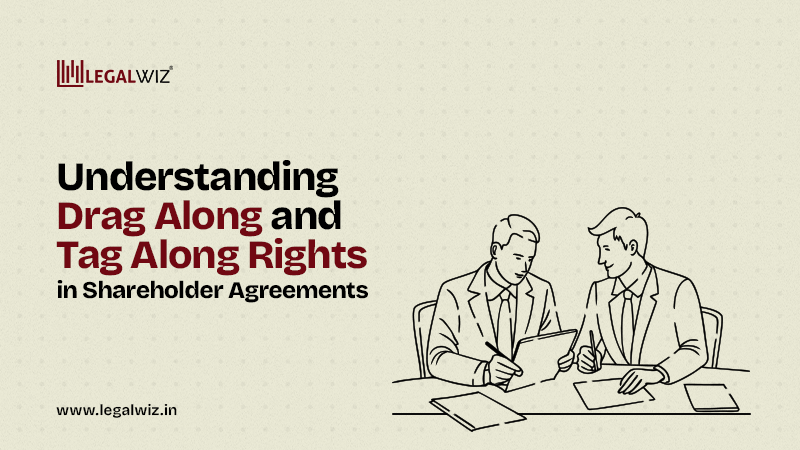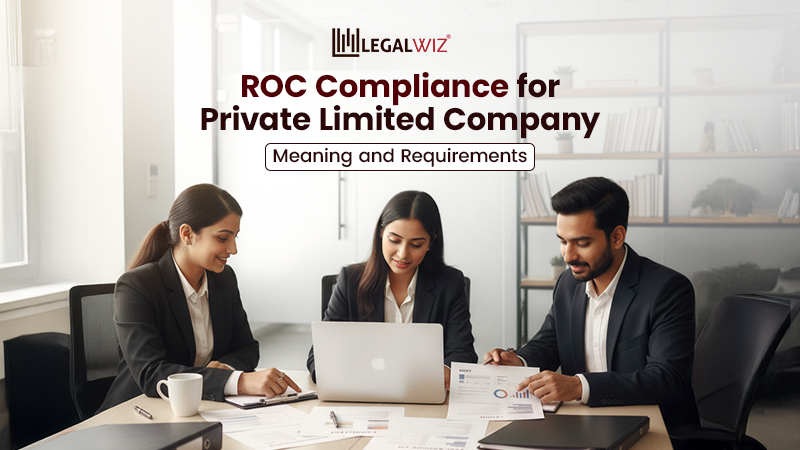Understanding Drag Along and Tag Along Rights in Shareholder Agreements
In the dynamic world of fundraising and startup investments, two terms often surface in every term sheet and shareholder discussion – Drag Along Rights and Tag Along Rights. These rights are not just legal jargon but are crucial instruments used by both investors and promoters to safeguard their exit options and financial interests.
In this blog, let’s dive into the definitions, key negotiation points, examples, and how these rights play a vital role in a Share Subscription and Shareholders Agreement (SSHA).
What are Drag Along & Tag Along Rights?
Drag Along Right: It gives the majority shareholders (often investors) the right to force minority shareholders to sell their shares if a sale of the company is agreed upon. This ensures smooth, 100% acquisition without dissent from minority stakeholders.
Tag Along Right: It gives minority shareholders the right by to join in a sale initiated majority shareholders on the same terms and conditions. This protects minority interests in liquidity events.
Why Do Investors Care?
Investors, especially VCs and PE firms, are always keen on:
- Ensuring complete exit when a strategic sale or acquisition happens
- Avoiding roadblocks from minority shareholders
- Maintaining leverage in exit negotiations
These rights help maintain transparency and protect against potential holdout problems.
Before You Sign: Key Negotiation Points to Define
1. Who Holds These Rights – Only Investors or Promoters Too?
- Typically, drag rights are reserved for majority investors.
- Promoters may also negotiate to hold these rights, especially if they are instrumental in bringing in the acquirer.
- Tag along rights are designed to protect minority shareholders, such as early-stage investors or co-founders.
Why It Matters: This determines the balance of power. If only investors hold these rights, promoters may lose control over exit events. Ensure clarity on holders and beneficiaries.
2. What Threshold (%) is Required to Trigger Drag Along?
- Usually defined as 60%, 66% or 75% of total voting shares.
- Prevents a small group from forcing a sale.
Tip: Align this with your shareholding pattern and investment stage.
3. What Happens if Minority Shareholders Resist?
- The agreement must clearly mandate compliance.
- Remedies could include:
- Appointment of a nominee to execute transfer on their behalf
- Suspension of voting or transfer rights
- Legal enforcement through specific performance
Important: Ensure these rights are backed by the AOA and enforceable under contract law.
4. Timelines and Notice Process for Execution
- Must define:
- Notice period (15–30 days typical)
- Details to be included (buyer, price, terms)
- Required shareholder actions
Best Practice: Attach notice format as an annexure. Define communication method.
5. Can the Drag be Partial or Must It Be 100%?
- Most often, 100% exit is required.
- Partial drag may be allowed in specific structuring cases.
Caution: Buyers usually demand full control. Partial drags should be well drafted if negotiated.
Drag Along vs Tag Along: At a Glance
| Basis | Drag Along | Tag Along |
| Nature | Obligation | Right |
| Protects | Majority’s exit | Minority’s interests |
| Triggered by | Majority selling stake | Majority selling stake |
| Outcome | Forces minority to sell | Allows minority to join sale |
Are These Rights Investor-Friendly or Balanced?
- Drag Along Rights are more favorable to investors.
- Tag Along Rights protect minority shareholders, thus balancing control.
- Together, they create an ecosystem of fairness, but the balance depends on how they are structured in the agreement.
Is Amendment in AOA Required?
Yes. As per Section 2(5) and Section 10 of the Companies Act, 2013:
- Any special rights like drag/tag must be backed by the Articles of Association.
- If not already present, the company must pass a special resolution (75% approval) to amend the AOA.
Process to Amend AOA:
- Board Meeting – Approve the amendment
- Call EGM – Issue notice for shareholder meeting
- Pass Special Resolution
- File MGT-14 with ROC within 30 days
Sample Clause for SSHA
“In the event that holders of not less than 75% of the shares propose to sell their shares to a bona fide third-party purchaser, the remaining shareholders shall be obligated to sell all their shares (or a proportionate part thereof, as applicable) on the same terms and conditions. The Company and all shareholders shall execute all documents and take necessary actions to complete such sale.”
Trigger Events for Execution
These rights are executed when:
- The majority shareholder(s) receive a third-party offer
- Strategic acquisition or complete exit is proposed
- Secondary sale is initiated as part of a larger deal
Example: VC Fund X holds 70% in ABC Pvt Ltd. A global player wants to acquire 100%. Drag Along is exercised to compel the 30% held by early founders to sell and enable a clean transaction.
If Founder Y holding 5% refuses, the agreement allows VC X to nominate someone to execute documents on Y’s behalf, ensuring deal closure.
Why Are These Clauses Essential in VC Deals?
Almost every VC term sheet and SSHA includes these rights. They provide:
- Predictability of exit
- Liquidity and alignment of interests
- Safeguard for both majority and minority shareholders
Read More: Check our in-depth blog on Term Sheets here
How LegalWiz.in Can Help?
At LegalWiz.in, our legal experts can help:
- Draft or review your Shareholders’ Agreement
- Structure Drag Along & Tag Along clauses in your best interest
- Ensure AOA alignment and compliance
- Navigate term sheet discussions with confidence
Whether you’re a founder or an investor, our team ensures your agreement is legally sound and commercially wise.
Connect with us today to ensure your investment deal is safeguarded by smart contracts and robust clauses.

Labdhi Kochar
Labdhi Kochar is a legal whiz who makes startup laws sound almost fun (yes, really!). With expertise in business structuring, fundraising, and IP rights, she helps entrepreneurs turn their ideas into well-planned, legally sound ventures. Whether she’s building rock-solid business structures or simplifying compliance jargon, Labdhi believes legal knowledge should be practical and accessible. When she’s not decoding legal complexities, you’ll probably find her indulging in her true passion-shopping like it’s a full-time job!







